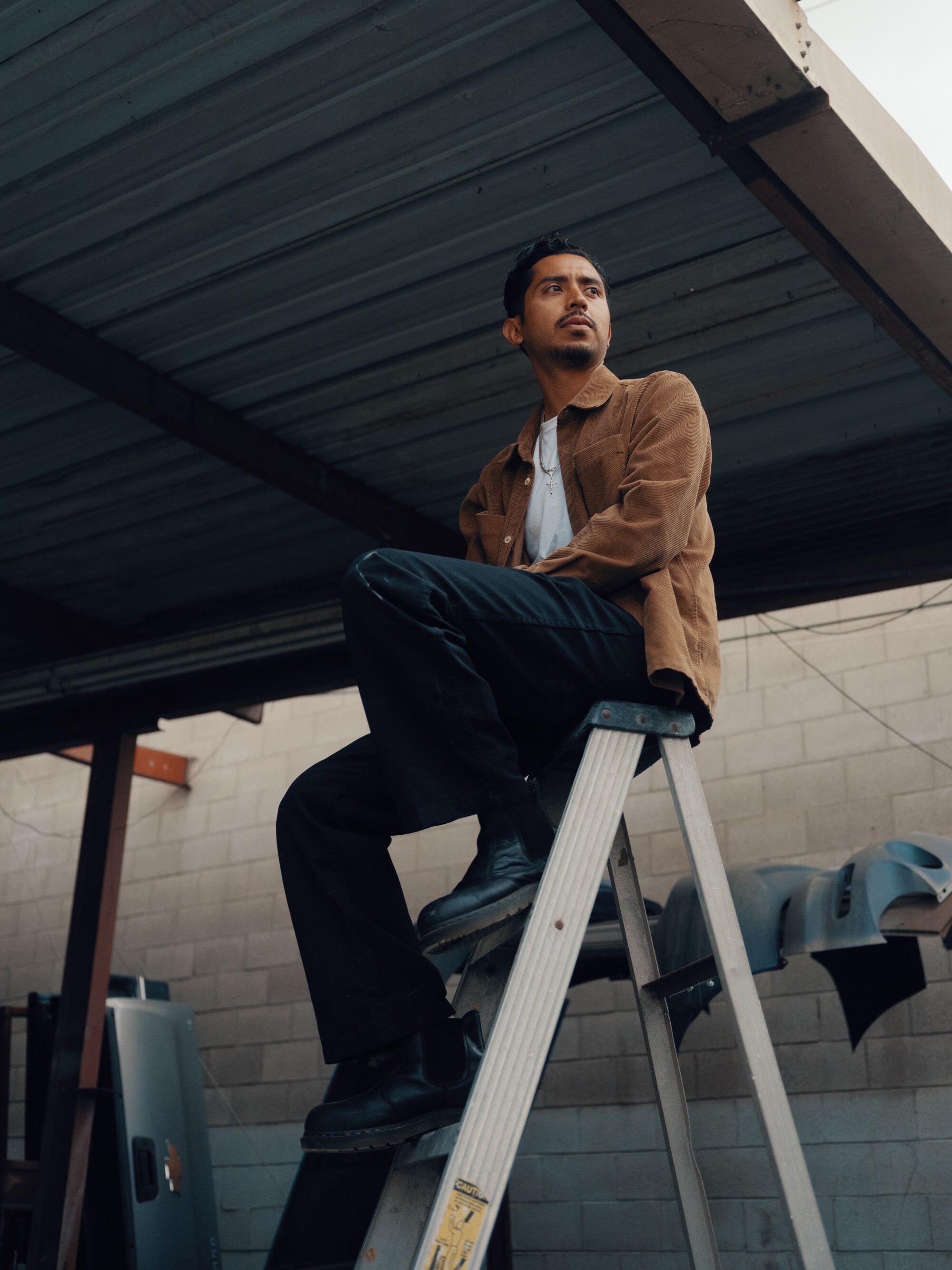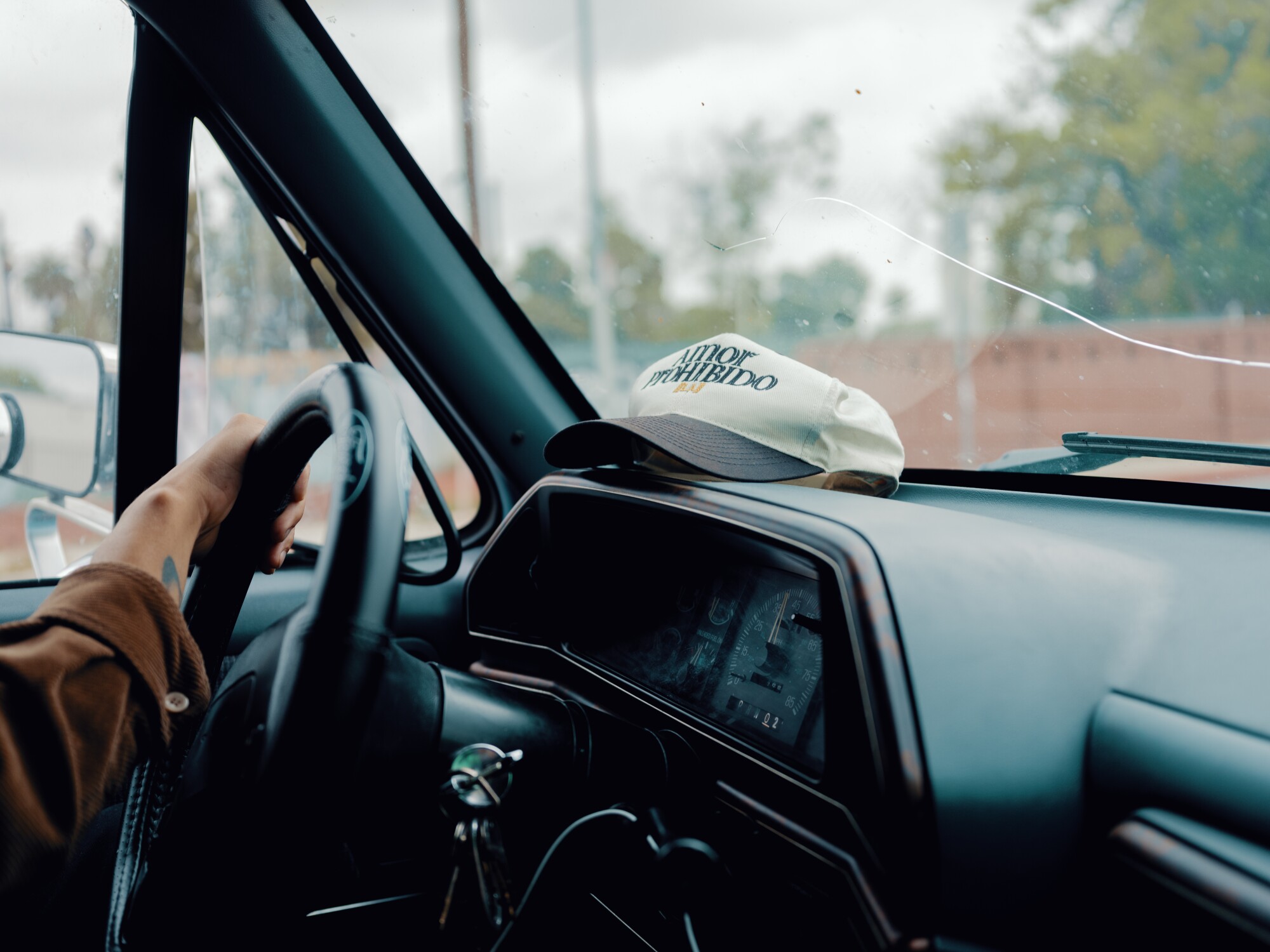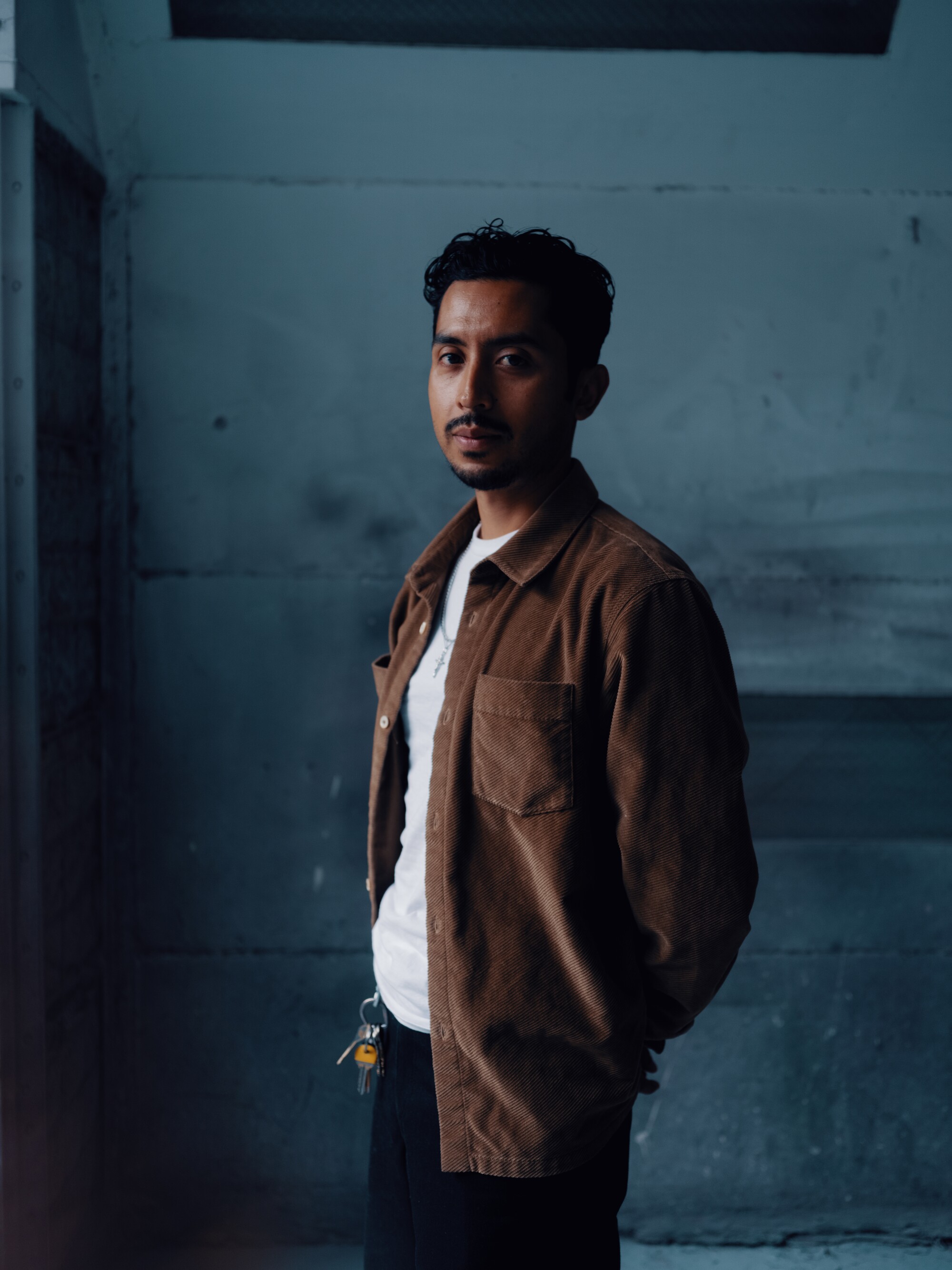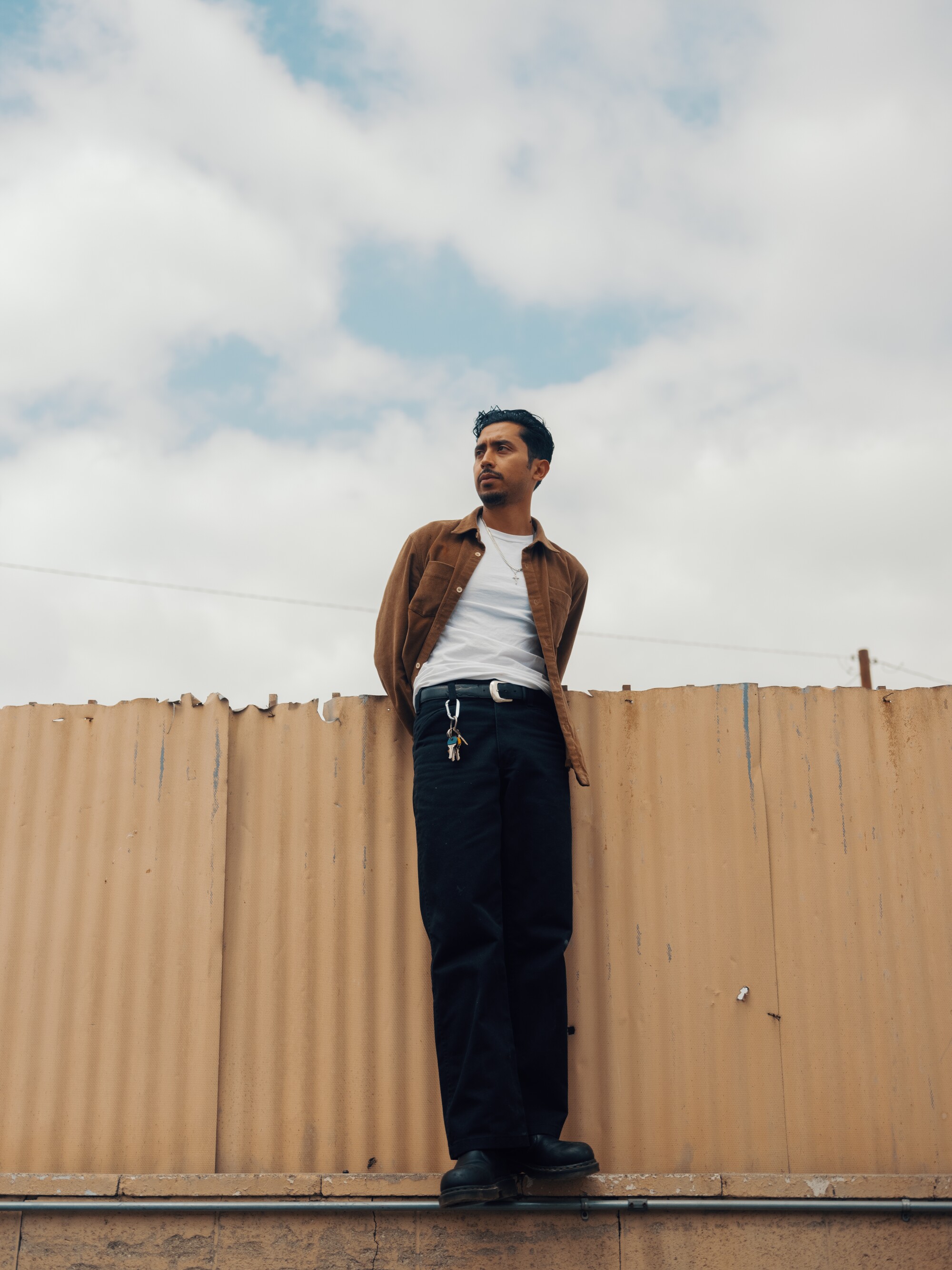
“A lot of the pieces are just me trying to make sense of things for myself now,” says artist and furniture maker Ryan Preciado.
(Adam Perez / For The Times)
This story is part of Image issue 11, “Renovation,” where we explore the architecture of everyday life — and what it would look like to tear it all down. Read the whole issue here.
Aretha Franklin’s “Day Dreaming” plays softly out of the speakers of Ryan Preciado’s ’91 baby blue Ford F-150, while an “Amor Prohibido” trucker hat slides across the dash. Behind the wheel, Preciado is giving what he calls “cholo-billy” — dark sunglasses, a tan corduroy button-up, a white T-shirt, black Ben Davis pants and Doc Marten Chelsea boots — as he talks about the process behind one of his latest pieces, the Pope cabinet (2021). The curvy, glossy emerald green cabinet, which Preciado built and painted at Jose Auto Body Shop in Boyle Heights to mimic the look and feel of a lowrider, was modeled after a pope’s miter. Preciado has a way of combining memories in his work; he grew up with the constant presence of both Catholic imagery and car culture. For him, making furniture is all about remembering.
“A lot of the pieces are just me trying to make sense of things for myself now,” he says. “I didn’t go to school for what I’m doing, so the way I go about things is very my own.”

Preciado first learned how to work with his hands from his dad, a car mechanic. His ’91 baby blue Ford F-150 is part of his process.
(Adam Perez / For The Times)
Being in this truck is a big part of his process. It’s where he feels at home. The pickup, which Preciado bought two years ago from an 80-year-old in Washington who kept it in good condition, is how he transports materials and finished pieces. The F-150 gets him everywhere he needs to go, usually without hassle. On this overcast Thursday afternoon, we’re headed to Bohnhoff Lumber Co. in Vernon to pick up some solid maple to finish a commission of six dining room chairs. Preciado is in a place right now where, as the kids might say, he’s popping off. In March, he closed his first show at Canada, a New York gallery, alongside painter Matt Connors, who has been championing Preciado’s work since he stumbled upon one of his chairs at South Willard gallery in Chinatown. On May 19, LACMA will be presenting two of Preciado’s pieces for acquisition, the Chumash chair and the Nipomo chair.
The commissions are piling up, in part thanks to how original and approachable the work feels. You know a Ryan Preciado piece when you see it. His works utilize curves and color in a way that’s classic and at the same time modern, but also in its own genre entirely. Bobbye Tigerman, LACMA’s Marilyn B. and Calvin B. Gross Curator of Decorative Arts and Design, is drawn to Preciado’s work as a conceptual designer because it’s “not only beautiful and beautifully made but is full of ideas.” Writer-editor Durga Chew-Bose, who wrote an essay for the publication “Body Forth / A Cliff to Climb,” which Connors and Preciado made in conjunction with their Canada NYC shows of those names, describes Preciado’s work as “kind, alive and curious, like a question mark.” “I can’t explain it, but the way our voices rise when asking a question, his approach to design has a similar tone,” she says.

Preciado at Bohnhoff Lumber Co.
(Adam Perez / For The Times)
Preciado’s furniture also feels like it’s part of a dialogue among friends. One reason is that he is, literally, partaking in a conversation with a cohort of L.A. artists — Diana Yesenia Alvarado, Mario Ayala, rafa esparza, Alfonso Gonzalez Jr. — whom he has worked with and considers his community. “I met them before I even knew what they did,” Preciado says. He once traded a chair and a lamp with Gonzalez for one of his paintings. “It’s so nice because we genuinely like each other’s stuff. There are conversations in our work going on all the time.”
All of these artists are telling a unique story about their surroundings, experience and identity. Preciado is a master of taking something he experienced either a long time ago or recently and excavating it through wood and steel and fabric. He says he doesn’t have a specific aesthetic, but each work has the feel of manifestation. Preciado describes his process as “making your dreams come true in a real way.”
Preciado is shy and speaks earnestly about the things he thinks are important, but a layer of dry humor reveals itself if you spend enough time with him. Both of his arms are covered in American traditional tattoos that he picked from a flash sheet and got for free from a friend but is admittedly starting to regret. He’s a Sagittarius and doesn’t know if that’s “good or bad.” He describes aspects of himself as soft, including the part that has a natural inclination toward petting stray cats and the version that’s captured in his Instagram profile photo, bottle-feeding a baby bird.
He was born in El Monte and grew up in Nipomo, a small ranchers town that’s technically on the edge of San Luis Obispo County but feels like its own thing. In Nipomo, he was always slightly out of place, he says. He’s half Mexican American and half Chumash Native American — and while he shares a special connection with his grandmother, Donna, who is Chumash and runs a cultural heritage shop in Guadalupe, Calif. — he felt out of touch with his mixed identity.
He spent the majority of his time skateboarding. This is an important part of understanding him not only as a person but as an artist. The lifestyle — spending all of one’s free time trying to find the center of gravity on a board and four wheels day in and day out — required constant exploration, creativity and artistry. Not so different from what Preciado does now. (Every Sunday morning, he still skates with a crew of friends around L.A.)
He moved out of his family’s house at 16 years old and crashed on friends’ couches. It wasn’t abrupt or dramatic, he says. He was just never home anyway. When he was in community college, he met Jory Brigham, a woordworker in Nipomo who would offer him an apprenticeship. The day Brigham offered him a job was the day Preciado quit community college. This is the place he was introduced to furniture making and fell in love with the craft. “There was definitely a real satisfaction of accomplishing this thing,” he remembers. “It’s kind of making your dreams come true in a real way.”

In March, Preciado closed his first show at Canada, a New York gallery.
(Adam Perez / For The Times)
When the person he was dating at the time wanted to move to L.A., Preciado didn’t hesitate. He’d always wanted to live in a big city, and the timing felt right. When he got here, he found out about a shop called South Willard, then in West Hollywood, and connected with the owner, Ryan Conder. They hit it off: On the day Preciado walked in, Conder had sprigs of sage laid out, which piqued Preciado’s affinity for native plants, passed down to him from his grandmother. After getting to know Preciado, Conder offered to introduce him to Peter Shire, the famed L.A. furniture maker who was part of the Memphis Group, and Preciado became Shire’s assistant. He was working for Conder simultaneously, helping open the gallery space when it moved to Chinatown.
It was during this time that he decided to make something of his own. The first piece was the Nipomo chair, named after his hometown and inspired by afternoons spent in his grandma’s garden. He remembered how one plastic chair she had outside for years had been warped by the sun and the elements into something that had curves and layers. “Everything felt so big, and I felt so safe in that space,” Preciado says. “So I wanted to give that opportunity to other people also.”
The chair itself, at 31 inches high and 40 inches wide, has deep plush cushions upholstered with Raf Simons x Kvadrat fabric and exaggerated curves and dimensions — something that might connect with a boomer with the same intensity it does a millennial. “His own designs are strange yet plain, like something you’ve seen before but can’t place because maybe it wasn’t real-real; like a chair from your favorite Saturday morning cartoon,” Chew-Bose says.
At South Willard, Preciado also got the opportunity to curate his own show, “Downhearted Duckling.” He included the work of Alvarado, Ayala, esparza and Gonzalez, people who he says helped him come to terms with himself, along with legends like Venezuelan sculptor and ceramicist Magdalena Suarez Frimkess, with whom Preciado collaborated to make a green, kidney-shaped table. “Throughout my life I have been culturally trying to piece myself together,” he wrote in the show notes. “I would like to give the opportunity for others to explore themselves as I have through these artists. To be proud of who they are.”

Preciado is a master of taking something he experienced either a long time ago or recently and excavating it through wood and steel and fabric.
(Adam Perez / For The Times)
Preciado has confided in esparza about his work since early on. After approaching esparza to be in the show, Preciado started telling him about the ways he felt robbed of his cultural heritage growing up in a predominantly white neighborhood. He told him about the Chumash chair, one of the first pieces he made, and how it was his way of grappling with this memory — and the larger memory of Native American erasure — and turning it into something new. “Rafa was so warm,” Preciado says. “It’s nice to have someone validate you and make you feel comfortable and safe.”
esparza asked if he could paint a portrait of Preciado for the show. The piece, called “Chumash Chair,” shows Preciado sitting in his design on the L.A. River, his brown skin and tattoos contrasting against his white tank top, his eyes crinkling from the sun. “It was like that literal feeling of being seen,” Preciado says of being painted by a friend and artist he admires.
When Preciado exhibited his own work at Canada NYC in February, it was this feeling again, of people seeing him for who he is through his furniture. He’s still processing the experience and adjusting to this new era in his career. “There were so many people at this opening, thanks to Matt Connors,” Preciado says. “I was so overwhelmed. It was nice. My [L.A.] friends flew out for the closing; my friend who owns El Prado flew out with cases of wine that he made.”
For one of the standout pieces in “A Cliff to Climb,” Preciado re-created his favorite photo of his mom, Ira. The photo, taken on grainy film when he was a kid, shows her on a pair of skates inside a roller rink, her arms outstretched, wearing a big, beaming smile. Her bangs and matching sweatsuit scream “cool ’90s mom.” As a piece of furniture, Ira becomes a 68-inch-tall, 60-inch-wide white shelf — it’s an inverted pyramid with four ledges and a brick-red sun detail at the top, made of medium-density fiberboard and aluminum laminate. “It’s a portrait,” says Preciado.
Preciado’s memories of various people and experiences — skateboarding from sunup to sundown in Nipomo, watching his uncles get romantic and sentimental about candy-colored lowriders, growing up with his grandmother teaching him the value of materials and heirlooms, not feeling secure in his cultural identity, being at the rink that one day with his mom — are often the things he seeks to figure out in his Arlington Heights studio. He’s keen on taking things that you see or encounter every day, especially those that might not seem like art, and making them art in your mind. In April, he talked about this idea at CalArts. “Imagine taking one of the eyesore buildings you see in downtown, and you shrank it and made a lamp out of it, and now it’s a beautiful object,” he says. “Looking at things in a different context is so cool.”

Writer-editor Durga Chew-Bose describes Preciado’s work as “kind, alive and curious, like a question mark.”
(Adam Perez / For The Times)
This approach is one reason his furniture feels so rooted in quotidian existence and daily routine. “Everything Ryan makes belongs to the world of meeting up and hanging out,” Chew-Bose says.
For Preciado, this moment feels open to possibility, especially in understanding himself as an artist. What’s worked for him so far is putting intention at the center of everything he makes. Without intention, a piece of medium-density fiberboard is just another cheap material, considered undesirable by most furniture makers — but with energy and emotion behind it, this piece of faux wood becomes a Ryan Preciado original. Almost like magic.
“I love this idea of manipulating something that’s so mediocre into something special,” he says.
More stories from Image
For all the latest Life Style News Click Here
For the latest news and updates, follow us on Google News.
